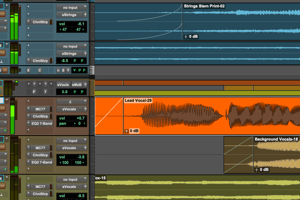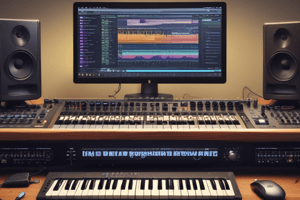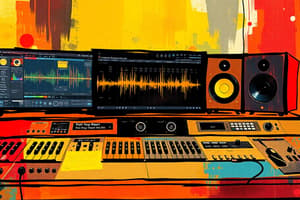Podcast
Questions and Answers
Which company initially developed Pro Tools?
Which company initially developed Pro Tools?
- Avid
- Steinberg
- Emagic
- Digidesign (correct)
Pro Tools was revolutionary because it was initially released as a software-only product, independent of specific hardware.
Pro Tools was revolutionary because it was initially released as a software-only product, independent of specific hardware.
False (B)
What fundamental concept has consistently defined the Pro Tools system since its inception?
What fundamental concept has consistently defined the Pro Tools system since its inception?
digital audio workstation
Brooks and Gotcher formed a company called ________ to offer upgrade EPROM microchips for the Drumulator.
Brooks and Gotcher formed a company called ________ to offer upgrade EPROM microchips for the Drumulator.
Which hardware component was critical in enabling Sound Tools to perform significant signal processing without overtaxing the computer's CPU?
Which hardware component was critical in enabling Sound Tools to perform significant signal processing without overtaxing the computer's CPU?
The release of Pro Tools 9 marked a shift in the product line, as it was the first version to operate without any specific hardware requirements.
The release of Pro Tools 9 marked a shift in the product line, as it was the first version to operate without any specific hardware requirements.
What is the name of Digidesign's first computer-based hardware direct-to-disk recording solution with a software front end?
What is the name of Digidesign's first computer-based hardware direct-to-disk recording solution with a software front end?
Pro Tools II introduced ________, a system that allowed complex routing of multiple digital audio signals between DSP cards.
Pro Tools II introduced ________, a system that allowed complex routing of multiple digital audio signals between DSP cards.
Match the Pro Tools versions with their key attributes:
Match the Pro Tools versions with their key attributes:
What significant advantage did licensing the Digital Audio Engine (DAE) provide to Digidesign during the early '90s?
What significant advantage did licensing the Digital Audio Engine (DAE) provide to Digidesign during the early '90s?
The Drumulator was successful primarily due to its highly customizable sound library.
The Drumulator was successful primarily due to its highly customizable sound library.
What was the name of the software released in 1985 that brought visual editing features of high-end instruments to a larger market?
What was the name of the software released in 1985 that brought visual editing features of high-end instruments to a larger market?
In 1994, Digidesign joined with American audio-visual giants ________, expanding its market influence.
In 1994, Digidesign joined with American audio-visual giants ________, expanding its market influence.
Which of these features was introduced in Pro Tools 5 (2001)?
Which of these features was introduced in Pro Tools 5 (2001)?
Pro Tools immediately replaced tape machines in professional studios upon its initial release.
Pro Tools immediately replaced tape machines in professional studios upon its initial release.
Which computer was identified by Brooks and Gotcher as having the audio potential necessary for creating digital audio recording and editing software?
Which computer was identified by Brooks and Gotcher as having the audio potential necessary for creating digital audio recording and editing software?
Before developing audio software, Digidesign's initial success came from providing ________ for the E-MU Drumulator.
Before developing audio software, Digidesign's initial success came from providing ________ for the E-MU Drumulator.
What piece of equipment did Digidrums use to record their samples prior to developing digital audio software?
What piece of equipment did Digidrums use to record their samples prior to developing digital audio software?
The Digi001 package was exclusively designed for professional studios and offered no tools for budget-conscious consumers.
The Digi001 package was exclusively designed for professional studios and offered no tools for budget-conscious consumers.
Match the Digidesign terms or products to their description:
Match the Digidesign terms or products to their description:
Flashcards
Pro Tools
Pro Tools
A digital audio workstation developed by Digidesign (now Avid), considered an industry standard.
Digidrums
Digidrums
Brooks and Gotcher's company that created upgrade EPROM microchips for the Drumulator drum machine.
Sound Designer
Sound Designer
Digidesign's groundbreaking Mac-based sample editing system for the Emulator II keyboard, released in 1985.
Sound Tools
Sound Tools
Signup and view all the flashcards
TDM (Time Division Multiplexing)
TDM (Time Division Multiplexing)
Signup and view all the flashcards
Pro Tools LE
Pro Tools LE
Signup and view all the flashcards
Pro Tools HD
Pro Tools HD
Signup and view all the flashcards
Pro Tools 9
Pro Tools 9
Signup and view all the flashcards
Study Notes
Pro Tools: The Industry Standard DAW
- Pro Tools is a digital recording solution from Avid, initially developed by Digidesign.
- It stands as a dominant force in the DAW world and is considered an industry standard.
- Most DAWs come from companies experienced in music software and hardware development, and Pro Tools is no different.
- The concept is based around the digital audio workstation, combining hardware and software.
Origins in the E-MU Drumulator
- The story begins in 1983 with E-MU's Drumulator drum machine.
- The Drumulator had EPROM-based memory for its 12-bit samples.
- The Drumulator was simple and users were limited to its built-in sounds.
- Evan Brooks and Peter Gotcher created new sound libraries for the Drumulator.
- Brooks and Gotcher formed Digidrums to offer upgrade EPROM microchips a year after the drum machine's release.
- Digidrums' chips offered alternative sounds, from Simmons electronic drums to John Bonham-inspired samples.
Digidrums and the Move to Software
- Brooks and Gotcher knew users would want more than preset sounds and sought a solution.
- They recorded Digidrums samples on Sony's PCM-F1 digital recording processor.
- They wanted a less cumbersome and more flexible option.
- They saw the audio potential of the new Macintosh computer.
- They created digital audio recording and editing software for their own use.
- The software was developed for general release.
- Digidrums partnered with E-MU, changed its name to Digidesign, and developed a Mac-based sample editing system for the Emulator II keyboard.
Sound Designer: A Groundbreaking Tool
- Released in 1985 for $995, Sound Designer brought visual editing to a larger market.
- The software was developed for each new sampler.
- Eventually, a Universal application was released, compatible with hardware from Akai, Roland, and E-MU.
Sound Tools: The First Direct-to-Disk Solution
- Sound Tools, released in 1989, was Digidesign's first computer-based hardware direct-to-disk recording solution.
- Brooks and Gotcher wanted to design a digital recording solution based on what they'd learned from Sound Designer.
- The Mac's 8-bit AD/DA conversion capabilities weren't sufficient.
- A separate 16-bit interface was connected to the Mac.
- Any serious signal processing pushed the computer's processor to its limit.
- Basic edits required the computer to process the signal.
- The solution came in 1987 with the Macintosh II, complete with six NuBus expansion slots.
- Brooks built an expansion card with a 16-bit DA converter and a Motorola DSP chip.
- Sound Designer used the DSP chip rather than the computer's CPU for audio editing.
- The prototype was shown off at the NAMM trade show.
- Digidesign developed a full audio input, output and processing system.
- They produced the 16-bit Sound Accelerator card, DAT-I/O digital interface, and AD In analogue interface.
Pro Tools: Multitrack Recording Arrives
- Released in 1991, the first version of Pro Tools was based around a hardware-software hybrid setup.
- It featured a four-channel interface.
- Priced at nearly $6,000, the software side was handled by Digidesign's ProEDIT program and a new version of OSC's Deck application.
- Relying on a third party to develop part of the Pro Tools software was a mistake.
- Version 2, released early in 1993, brought the software back in-house and introduced Pro Tools application.
- Pro Tools II introduced TDM (Time Division Multiplexing).
- TDM allows complex routing of multiple digital audio signals between DSP cards.
- TDM enables Pro Tools to run multiple real-time DSP-based TDM plug-ins simultaneously.
- In the early '90s, Steinberg and Emagic were readying audio-capable versions of Cubase and Logic.
- Digidesign opted to license its Digital Audio Engine (DAE) to other software developers.
- Users of other DAWs could run DSP-based TDM plug-ins without using the Pro Tools software.
Hardware and Market Expansion
- The Pro Tools concept combined hardware and software to create a complete package in the 1990s.
- Digidesign merged with Avid in 1994.
- Pro Tools progressed to 24-bit resolution and 24 tracks of audio by 1997.
- By the late 90s, Pro Tools was used alongside tape machines, and starting to replace them altogether.
- In 1999, Digidesign targeted the budget consumer market with the Digi001 package.
- Digi001 comprised a rackmount 24-bit 44.1/48kHz 8-in/8-out audio interface with 1-in/1-out MIDI connections.
- It had a PCI card with no DSP capabilities and Pro Tools LE, a stripped down 24-track version of the software.
- Updated versions were released over the years, with the addition of the 002 control surface/interface in 2001 and the arrival of the current 003 control surface and 003 Rack in 2007.
Pro Tools as an Industry Standard
- In 2002, Apple bought out Emagic, and Steinberg announced Cubase SX.
- Digidesign released Pro Tools HD, an update focusing on new hardware choices.
- The introduction of the 192 I/O interface and new HD Core and Process cards gave Pro Tools more recording flexibility than ever before.
- Pro Tools has defined the workflow of most modern studios.
- Beat Detective, Elastic Audio and Elastic Pitch have become essential tools for recording and mix engineers.
- In recent years, the Pro Tools product line was rebranded as an Avid product.
- The software is available in three varieties: Pro Tools 9, 9 HD Native and 9 HD.
- The former is roughly equivalent to the previous LE or M-Powered editions.
- For the first time, there are no specific hardware requirements for Pro Tools 9.
- HD Native is the full software package for non-DSP Digidesign hardware, while HD is the full TDM-equipped flagship product.
Legacy
- Pro Tools has revolutionized the way music is recorded, edited, and mixed using computers.
- The release of PT 9, hardware independence, and continual enhancement of the feature set have solidified Pro Tools as an industry standard.
Studying That Suits You
Use AI to generate personalized quizzes and flashcards to suit your learning preferences.





